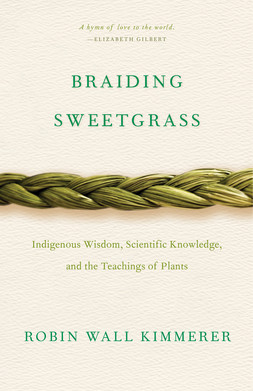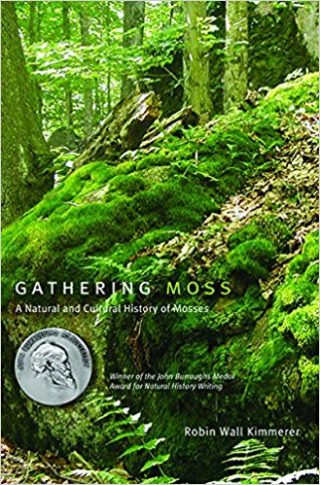The Many Lenses of Robin Wall Kimmerer
Posted in From the Library on November 14 2017, by Esther Jackson
Esther Jackson is the Public Services Librarian at NYBG’s LuEsther T. Mertz Library where she manages Reference and Circulation services and oversees the Plant Information Office. She spends much of her time assisting researchers, providing instruction related to library resources, and collaborating with NYBG staff on various projects related to Garden initiatives and events.
 I first discovered the writings of Robin Wall Kimmerer, Ph.D., when taking the NYBG Plant Diversity course taught by Dr. James Boyer. As we covered the different groups of plants in class, I wanted to learn more. When it came time to learn about mosses, Kimmerer’s Gathering Moss: A Natural and Cultural History of Mosses was my supplemental reading of choice. By the time I was done with the book, I was hooked. I quickly purchased and read Braiding Sweetgrass: Indigenous Wisdom, Scientific Knowledge, and the Teachings of Plants, eventually donating my copy to the NYBG Library’s circulating collection and heartily recommending it to those who visit the library looking for reading suggestions. When I learned that Kimmerer would be lecturing at NYBG in December, I leapt at the chance to tell readers of Plant Talk about these two books that I had so enjoyed.
I first discovered the writings of Robin Wall Kimmerer, Ph.D., when taking the NYBG Plant Diversity course taught by Dr. James Boyer. As we covered the different groups of plants in class, I wanted to learn more. When it came time to learn about mosses, Kimmerer’s Gathering Moss: A Natural and Cultural History of Mosses was my supplemental reading of choice. By the time I was done with the book, I was hooked. I quickly purchased and read Braiding Sweetgrass: Indigenous Wisdom, Scientific Knowledge, and the Teachings of Plants, eventually donating my copy to the NYBG Library’s circulating collection and heartily recommending it to those who visit the library looking for reading suggestions. When I learned that Kimmerer would be lecturing at NYBG in December, I leapt at the chance to tell readers of Plant Talk about these two books that I had so enjoyed.
Kimmerer is a compelling writer who has the ability to look at plants—organisms—through multiple lenses. Her formal training in botany has given her the ability to write about plants as a scientist, while her work with indigenous cultures and their history gives her writing a highly-personal and humanized perspective. Her works are immensely readable and delightful to those who love plants, ecology, and the interactions between humans and the environment. Although a collection of personal essays, Gathering Moss has more of a scientific grounding, whereas Braiding Sweetgrass is more interdisciplinary, and more appropriate for a general audience. Both are interesting and engaging and can be enjoyed by scientists and non-scientists.
 Because Kimmerer bridges so many worlds with her writing, and because her writing inspires feeling as much as it educates her readers, I find it difficult to review her work in a more systematic, clinical way.
Because Kimmerer bridges so many worlds with her writing, and because her writing inspires feeling as much as it educates her readers, I find it difficult to review her work in a more systematic, clinical way.
I would like to encourage those who have been intrigued by my words to find copies of her books and experience her writing for themselves. Kimmerer will also speak at NYBG on December 1 of this year, presenting a talk titled What Plants Can Teach Us. Readers can register for this event here.
I would like to close my review with a quote from Elizabeth Gilbert that summarizes the allure and power of Kimmerer’s writing. Gilbert writes: “Robin Wall Kimmerer is a writer of rare grace. She writes about the natural world from a place of such abundant passion that one can never quite see the world the same way after having seen it through Kimmerer’s eyes. In Braiding Sweetgrass, she takes us on a journey that is every bit as mythic as it is scientific, as sacred as it is historical, as clever as it is wise. She is a great teacher, and her words are a hymn of love to the world.”

